Some 20-30 years ago, Kyushu bonsai hobbyist Mr. Honda began buying pine trees from Nomoto Chinshoen, a Miyazaki bonsai nursery. As the trees had little in the way of branching, Honda planned on developing the branches on his own. He’s done quite a job.

Black pine bonsai
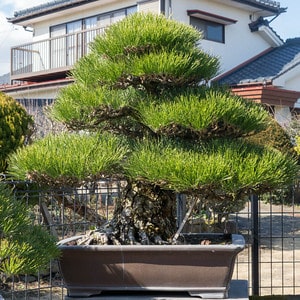
Japanese black pine
The trees aren’t particularly old – many of them 40 years give or take. The branches were developed over about 20 years.
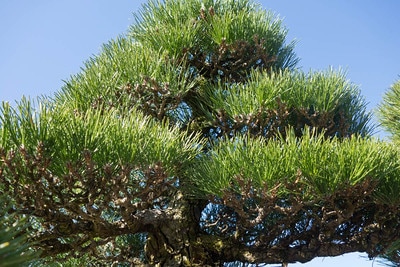
Well developed branches
Honda has a relatively small collection, but the trees all look great. I couldn’t believe what a great job he’s done developing these pines.
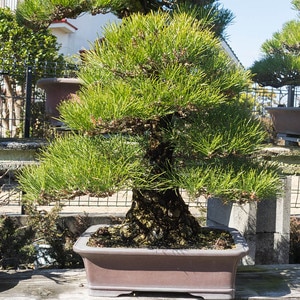
Black pine
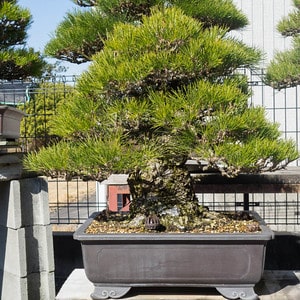
Black pine
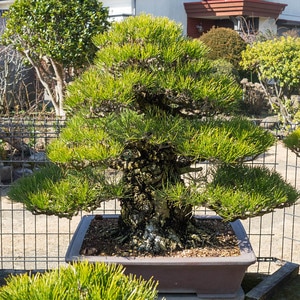
Black pine with large trunk
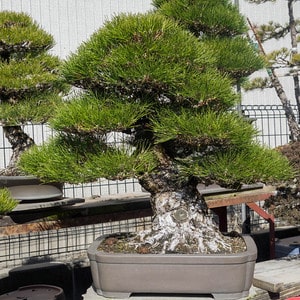
Yet another black pine
The trees relatively young age was evident by looking closely at the trunk. Although the roots were impressive – and likely the result of seedling-cutting – the bark had yet to develop the furrows I’ve seen in other trees of similar age. I don’t know if these trunks were grown in the ground or in containers, but it appears they were created using a number of escape branches gauging by the scars.
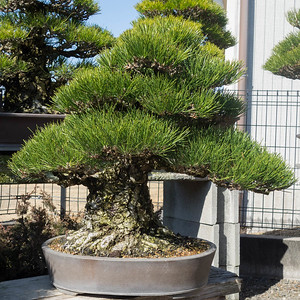
Large black pine
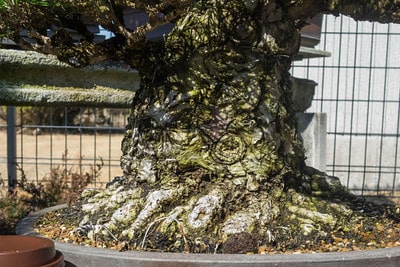
Lower trunk and roots – although the tree is powerful, the bark looks young
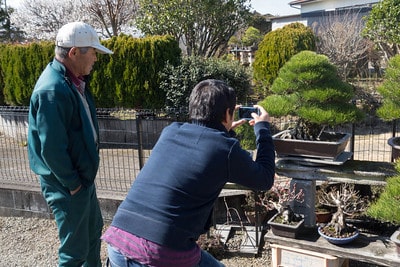
Mr. Honda and Daisaku Nomoto taking a photo
Honda didn’t have many young pines at the house, but there were a few, and yes, they were growing in colanders.
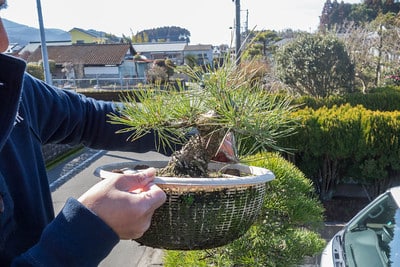
Young pine
The day was sunny but cold. It was about this time that Honda opened a thermal container and pulled out three coffees, a welcome sight. We moved on to the upper garden where he keeps his white pines and deciduous trees. I was immediately struck by a trident maple. Apparently Honda has a pretty good understanding of deciduous trees too.
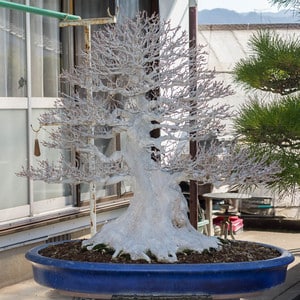
Trident maple – wow!
Below the benches I found a number of small chojubai.
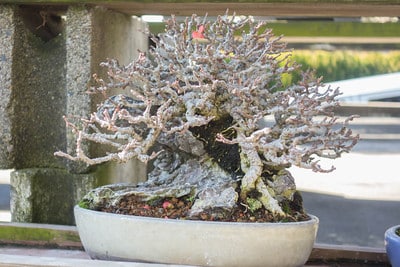
Root over rock Japanese flowering quince ‘chojubai’
Boy do I like this variety. Honda says he removes all but the interior leaves once a year, possibly in June, and cuts back to about two buds when shoots reach 1-2″ long. The approach seems to be working.
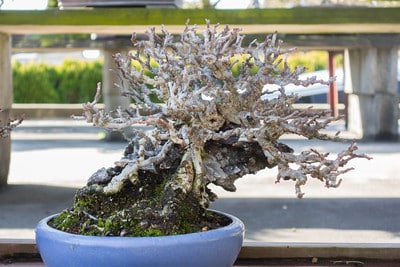
Root over rock chojubai
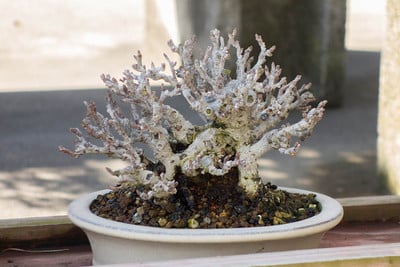
Chojubai
Nestled here and there were a few small shimapku with fun movement.
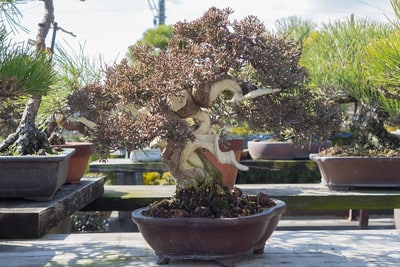
Sargent juniper, aka shimpaku
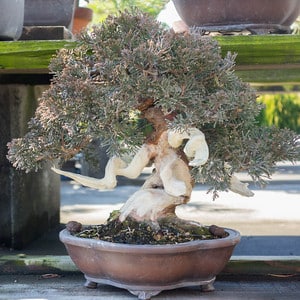
Shimpaku
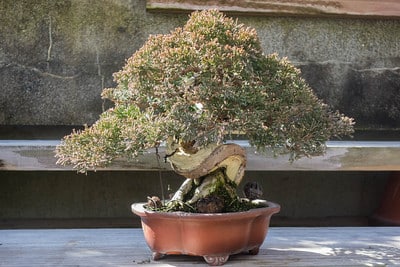
Shimpaku
Across the street an empty lot is put to good use – Miyazaki mountains rise to the southeast.
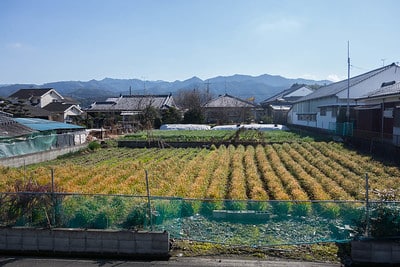
View from Honda’s garden
Subscribe to Bonsai Tonight
New Posts Delivered Every Tuesday and Friday
john romano says
Hi Jonas,
Another interesting post. I’ve found in my few travels with Mr. Urushibata and others that the heart of bonsai in Japan is with many of the serious hobbyists. There is a real love of bonsai there and they often provide a source of material to many of the ‘masters’ who further refine them. This is especially true in the shohin bonsai world.
john romano
Mac says
This is a part of bonsai that I hadn’t seen before. You “exposing” the bonsai hobbyist in Japan is very much appreciated.
I see a book in this. How about it? No one has ever written about the hobbyist in Japan, only the very famous.
Mac says
A chapter on a particular person and his collection, methods, inspiration and so fourth.
Brian McGrath says
That trident mama Mia
Does he have a process that leaves the bark so light in colour. It is just a beautiful thing.
Qualicum Brian
Dennis Robertson says
Yes, especially about buying developed field material from bonsai nurseries and taking it from there. We then learn that experts as well as hobbyists with a bank account spend quite a bit on mature trees to refine them further. This is a somewhat of an awakening to the freshman who becomes aware that what is also being purchased is “time.”
Brian McGrath says
I am not too familiar with red pines. I seen a picture in one of your earlier posts of a red pine and it looked like it had been grafted onto a jbp truck similarly to a jwp. Do they sometimes go through the same grafting process. Or is there no benefit like you have with white pine on black pine stock.
Qualicum Brian
Jonas Dupuich says
Thanks for the notes,
Mac – that sounds like a very fun project – it might warrant a longer trip next time.
Brian – one reason for the light colored bark is genetics. When growing maples, bark quality and leaf/internode size are a good starting point for selecting material to work with. Not holding the trunk during repotting can also help maintain the white color (avoids akadama and other soil residue getting into the bark).
As for red pines, as far as I’ve seen, it’s not too common to graft them on to black pine trunks. Leveraging black pine trunks can be a shortcut to developing bonsai with large trunks and good bark – one reason why white pine is often grafted onto black. Red pines have their own character as bonsai and can develop great bark in some specimens. That said, the foliage can be used elsewhere as well: http://crataegus.com/2010/03/29/grafting-on-ponderosa/